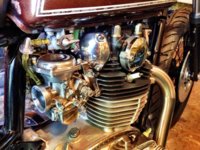Ok, Looks like I may need a little more help with this. Think I need to take a step back and start at the beginning again. I am posting a picture of my carbs to help with identification. They are as far as I know bs38s, and they are for sure the original carbs from this 74 canadian tx650. I did however have them gone over by oldskoolcarbs, he may have changed the jets based on my description of the modifications I made so I cant confirm they are the original jet sizes. When I first got her running again the jet sizes were
pilots 45
mains 135
needle position 4
needle number unknow, I will double check tomorrow.
Performing dead cylinder method I found that achieving highest idle required my idle screws to be turned in all the way, this made me drop the pilot jet size to a 42.5. Now my idle screw finds highest idle at around 1/2 turn out from all the way in, which feels pretty good to me, idle is nice, off throttle is crisp. At this setting I have also measured exhaust emissions and found CO to be at 5% which should put me at 12.6:1 this is still a bit on the rich side if you compare to other aircooled engines but i am trusting the dead cylinder method more than I am the gas analyzer for the time being.
Now on to my problems. My advance mechanism shaft end play is corrected. Timing light shows my line just right of the fire mark on the sticker for my pma. I have purposely set it here because when my advance comes on my line shows just a hair past the advance line (left) of the mark on the pma sticker. I figured I would try to balance the little bit of too much advance (maybe 1mm) with a little bit of retard off advance (1-2mm). Previous on advance my line would jump around a bunch with the timing light, now with my shaft issue resolved the line is pretty consistent when in the advance position. For all purposes I feel my advance system is working as designed.
Symptoms. Starts and runs sweet, nice crisp throttle response off idle. Driving at low speed is excellent. Up to about 30% throttle twist bike pulls smooth and hard. When I go for more than 30% throttle it breaks apart allot. Doesnt feel like it powers out, such as how it is described when you encounter a lean condition, this is more like quick hard cutting out types of sensations. Pretty much at any throttle position above 30% I get no consistant hard pulling of the engine, sometimes I even get a sharp back fire on hard accel.
I dont have fresh plugs on hand but the ones I am using show a very clean white ceramic tower with a very clean and white-ish electrode. Down low in the bottom of the ceramic it is dark black and sooty... with that said, I think some of this black soot could be left over from idling it allot with the richer pilot jets, as back then my plugs were totally black and sooty. I am using the iridium plugs from mikes.
I have tried, 132.5, 135, 137.5, 140, and 145 mains. All of these jets have seemingly changed my symptoms very little, I still get the break up under mid to hard throttle.
I have also tried positions 3, 4, and 5 on my needle. position 3 may have produced the worst break up on mid throttle.
So in conclusion, im scratching my head a bit. I don't feel much or any of the combinations have yielded much feedback that I am heading in the right or wrong direction. In the carb guide it show a 74 tx650 to have a 127.5 main, a 45 pilot jet and position 4 clip on the needle.
Could I be way too rich on my main? My plugs dont seem to show that but maybe its a possibility? I am going to try position 2 and 1 on my needle over the weekend to see whats up, I am out of main jets to try so I either need to order some some even larger ones and perhaps some smaller ones.
Any body have any thoughts on this? Suggestions?
Feeling frustrated. Here is a short clip showing low speed acceleration, seems to sound pretty good and strong, no missing, surging or stumbling... but like I said, once I grab some more throttle it just falls apart.



